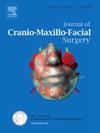基于磁共振成像的颞下颌关节滑膜软骨瘤病治疗临床指导:一家机构的经验。
IF 2.1
2区 医学
Q2 DENTISTRY, ORAL SURGERY & MEDICINE
引用次数: 0
摘要
这项回顾性观察研究旨在为颞下颌关节滑膜软骨瘤病(TMJ-SC)的临床治疗引入一套全面的磁共振成像评估标准。根据核磁共振成像评估系统(骨侵蚀、范围、关节盘状况、位置、成熟度和疏松体大小),患者接受了不同的治疗。患者至少接受了两年的随访,以评估肿瘤复发情况、疼痛视觉模拟量表评分(VAS)和最大椎间隙开度(MIO)。在纳入的 195 名颞下颌关节囊肿患者中,34 人接受了关节镜手术,161 人接受了开放手术。在SC范围较大的患者中,32人接受了髁状突颈部或颧弓临时切除术,2人接受了耳鼻喉科联合治疗。28 人接受了关节盘重建术,56 人接受了椎间盘复位术。患者的关节功能恢复良好,在术后平均 75.1 个月的随访中仅有 2 例肿瘤复发。MIO从30.2毫米增至40.0毫米(P < 0.0001),VAS从5.1降至0.78(P < 0.0001)。本文章由计算机程序翻译,如有差异,请以英文原文为准。
Clinical guidance based on MRI for the management of temporomandibular joint synovial chondromatosis: One institution's experience
The aim of this retrospective observational study was to introduce a comprehensive MRI evaluation criterion for the clinical management of synovial chondromatosis of the temporomandibular joint (TMJ-SC). Patients received different treatments according to the MRI evaluation system: bone erosion, extent, articular disc condition, location, maturity, and size of loose body. At least a 2-year follow-up was completed to assess tumor recurrence, visual analogue scale score for pain (VAS) and maximum interincisal opening (MIO). Of the 195 patients included for TMJ-SC, 34 received arthroscopy and 161 received open surgery. Among the patients with significant extent of SC, 32 received temporary resection of the condylar neck or zygomatic arch and 2 received treatment combined with ear, nose and throat(ENT). 28 received articular disc reconstruction and 56 received disc repositioning. Patients showed good recovery of joint function with only two cases of tumor recurrence at an average follow-up of 75.1 months after surgery. The MIO had improved from 30.2 mm to 40.0 mm(P < 0.0001) and VAS had decreased from 5.1 to 0.78(P < 0.0001).The preoperative MRI evaluation principles has been effective in selecting appropriate surgical options.
求助全文
通过发布文献求助,成功后即可免费获取论文全文。
去求助
来源期刊
CiteScore
5.20
自引率
22.60%
发文量
117
审稿时长
70 days
期刊介绍:
The Journal of Cranio-Maxillofacial Surgery publishes articles covering all aspects of surgery of the head, face and jaw. Specific topics covered recently have included:
• Distraction osteogenesis
• Synthetic bone substitutes
• Fibroblast growth factors
• Fetal wound healing
• Skull base surgery
• Computer-assisted surgery
• Vascularized bone grafts

 求助内容:
求助内容: 应助结果提醒方式:
应助结果提醒方式:


